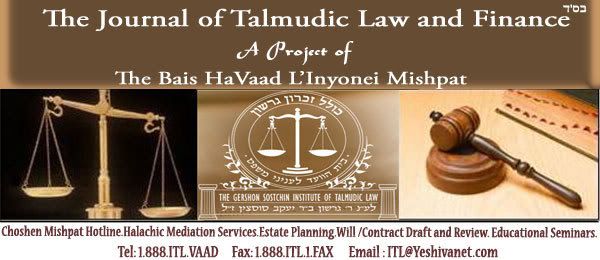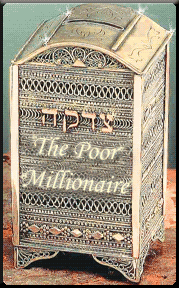 Depreciation of Assets and Ma’aser
Depreciation of Assets and Ma’aser
By: Rabbi Dovid Bendory
(Ed. note.: The current unprecedented condition of the U.S markets and the global economic meltdown have severely depreciated the value of businesses, homes and investment portfolios. Hardly a day goes by that we do not hear of another severe detrimental downswing in an important segment of the global economy. The current situation not withstanding depreceation is a concept which plays a role in the normal functioning of an economy as well. The following piece is an analysis of the basic concept of depreciation as it relates to business expenditures and ma’aser kesafim.)
Ma’aser was once a relatively straightforward matter: plant, harvest, give about 2% to the Kohen, 10% of what remained to the Levi, 10% of the remainder to maaser sheini; the remaining 79.38% is yours. Today, even those simple farmers face a slew of complex business calculations in running their farms, and that makes the accounting of ma’aser much more complex.
Depreciation as an Accounting Principle
Ploni Ikkar has a farm which earns $10,000 per year. As a Yireh Shamayim, Ploni tithes $1,000 to tzedaka. Unfortunately, Ploni’s plough broke and a new plough will cost him $10,000, an entire year’s profits. What impact will this plough have on Ploni’s earnings and ma’aser?
Let’s assume Ploni has enough money saved away to purchase a new plough, and is willing to do so to keep his business running.
For accounting purposes, a business treats the purchase of equipment like the plough as a capital expenditure rather than an operational expense [1]. Ploni has effectively “swapped” his $10,000 in cash for $10,000 worth of plough. But unlike the cash which retains its value, the plough will wear out over time. Tax calculation allows Ploni to utilize an accounting fiction known as depreciation, to factor the cost of the plough against his income. Given that the typical plough lasts 20 years, Ploni deducts 1/20 of the cost — $500 — each year for the next 20 years of the plough’s life. Or in other words, in each of the coming 20 years, Ploni earns $9,500 rather than $10,000 for accounting purposes2.
Does Depreciation factor into Ma’aser?
For maaser accounting, Ploni deducts the same $500 from his income and therefore earns $9,500 in each of the coming 20 years3. The accounting fiction is a halachic reality.
The Implications of Depreciation on Ma’aser as the Years Progress
Let’s say Ploni gets lucky and his plough outlasts the expected 20 years. Ploni’s maaser income is now $10,000, just as it was before he bought the plough. If, after 20 years, Ploni sells the plough for $1,000, he owes ma’aser on the sale. Since the plough was held and used for business purposes, its purchase was effectively an investment in Ploni’s business. And since he has already depreciated away the full cost of the plough in the first twenty years of usage, the $1,000 sale price is pure income on which he owes $100 of ma’aser.
If Ploni sold the plough in year 10 for $5,000 — exactly equal to the residual (un-depreciated) value, this $5,000 is not income for ma’aser purposes. Just as the original purchase “swapped” $10,000 of cash for $10,000 of plough, this sale “swaps” $5,000 of plough for $5,000 worth of cash. There is no profit nor loss involved.
If he sells it for $7,000 he would owe $200 dollars of ma’aser (on the $2,000 dollars which were profit over the value of the plough4.
If he sells it for $3,500, Ploni has taken a loss which is deducted against his other income. Just as he owed ma’aser on profits, so too can he deduct his losses if he sells for less.5
What if Ploni borrowed money to purchase the plough?
Let’s assume that instead of buying the plough on his own, Ploni turns to Akum Bank for a loan. Akum Bank requires Ploni to pay for $2,000 of the plough himself and lend him the other $8,000 payable at 10% interest compounded annually over the coming 10 years. What is the impact on ma’aser calculation?
It is easiest to understand this situation if we consider that Ploni has two completely separate transactions.
1. He purchased a plough for $10,000 which he depreciates as discussed above.
2. In addition, Ploni has borrowed $8,000 with an interest bearing loan which he must repay as follows. Each year Ploni makes a single payment of $1301.96 consisting of principle and interest. The percentage of the payment which is interest and the percentage which is repayment of principle affects his ma’aser calculation. In year one, $501.96 of his payment is principle; and $800 is interest. The principle payment has impact on his cash flow but no impact on his earnings as he is simply repaying the $8,000 that he borrowed. The $800 in interest is an operational expense that is deducted from income for ma’aser. Thus instead of earning $9,500 (his income less the depreciation of the plough) his gross ma’aser income was $9,500 minus $800, which equals $8,700. He owes $870 in ma’aser.
In each of the coming years, Ploni will pay off increasing amounts of principle and decreasing amounts of interest until year ten in which he pays $1,183.65 in principle and $118.36 in interest. His maaser for that year is $938.16. Note that as the loan progressed, Ploni paid more principle and less interest each year; thus his cash flow due to the loan remained unchanged, but his ma’aser gradually increased.
These examples lay out the principles of depreciation, (and also amortization and depletion which are handled similarly) for ma’aser accounting. In this case, we can calculate our ma’aser obligation exactly as we account our income for tax purposes. Other areas of ma’aser accounting are more complex, especially where they differ from tax accounting.
Rabbi Dovid Bendory is Vice President of Risk Management Technology at Goldman Sachs in New York City where he has worked for the past 15 years. He is the Executive Director of Pidyon, a kiruv organization dedicated to redeeming the spiritual captives of our time. Rabbi Bendory received his Semicha in Yerushalayim, 2005 from HaRav Zalman Nechemia Goldberg.








 The Poor Millionaire
The Poor Millionaire








